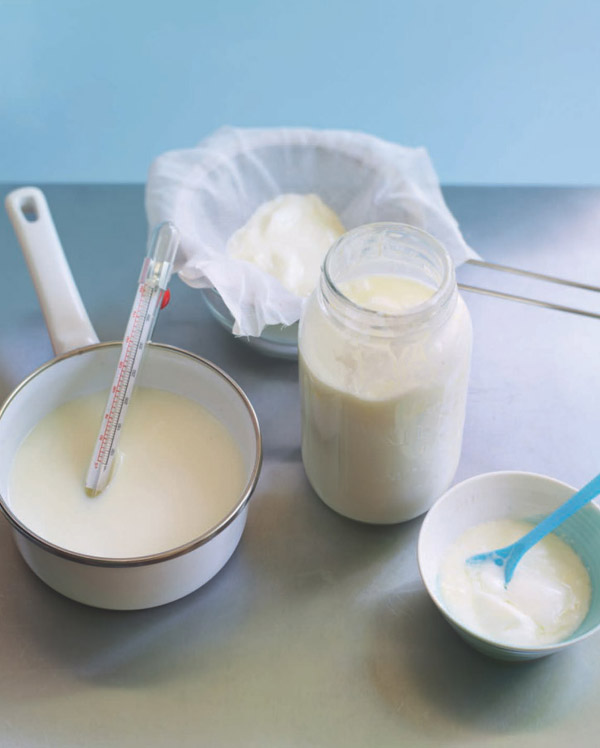
Yogurt is immensely rewarding to make and once you’ve made your first batch of yogurt, you can reserve a portion of it to use as a starter for the next; just make sure you use live yogurt for your starter and it’s very fresh.
‘Live’ on the label signifies a yogurt that has been fermented with a starter culture bacteria, such as lactobacillus acidophilus. The beneficial bacteria in live or bio yogurt helps to restore the internal flora of the gut by encouraging ‘friendly’ bacteria, aiding digestion and gastrointestinal problems and suppressing the effects of ‘bad’ bacteria. Yogurt is also a good source of calcium and B vitamins.
A special yogurt maker isn’t necessary here, but you will need a kitchen thermometer and a mason or screw-top jar. It’s also important to be scrupulous about hygiene, so make sure your equipment is sterilized before you start.
Depending on what time of year you make yogurt, you will need to consider how to keep it warm while it cultures. In hot, sunny weather, wrap the jar in layers of towels and a black plastic bag and this should be sufficient to keep the contents warm, while in the colder winter months a thermos flask, warm airing cupboard or an oven heated to 100°F/38°C are possible alternatives.
Howto make live yogurt
This recipe makes about 1 litre/1 quart of fresh-tasting, light yogurt, which is perfect in smoothies and lassies, but you could use a whole milk yogurt for a creamier, richer end result. Instead of cow’s milk, sheep’s or goats’ milk are both options.
1 litre/4 cups organic semi-skimmed/low-fat milk
3 tablespoons organic plain live yogurt
1 Pour the milk into a large, heavy-based saucepan and bring slowly to boiling point over a medium-low heat, stirring occasionally to prevent the milk burning on the bottom of the pan; it should read 185°F/85°C on a kitchen thermometer. Once the milk has reached this heat, keep it there for about 10 minutes, stirring occasionally. You may need to turn the heat down to low during this time.
2 Turn the heat off, remove any skin that has formed on the surface of the milk and leave the mixture to cool to 110°F/43°C, uncovered and stirring occasionally. This usually takes around 40–45 minutes.
3 Spoon the live yogurt into a 1-litre mason or screw-top jar/a 4-cup sterilizing canning jar and pour in a quarter of the warm milk. Stir well until combined, then add the remaining milk and stir again. Fasten the lid and wrap the jar in clingfilm/plastic wrap, towels and then a black plastic bag to keep the warmth in.
4 Leave the jar a warm place, ideally around 100°F/38°C, for 8 hours or overnight until set. Alternatively, transfer the milk mixture to a warmed Thermos flask and leave for 8 hours or overnight until set. When ready, stir well and chill in the fridge until ready to eat; it will thicken up a bit more as it cools. If you want a Greek-style yogurt, line a sieve with a double layer of muslin/cheesecloth and strain the yogurt over a bowl in the fridge for about 1 hour until it is thick and creamy; the whey in the bowl can be used in smoothies and blends. Store the yogurt in the fridge for up to 1 week.